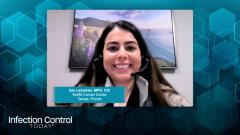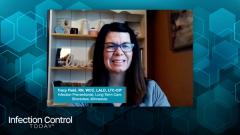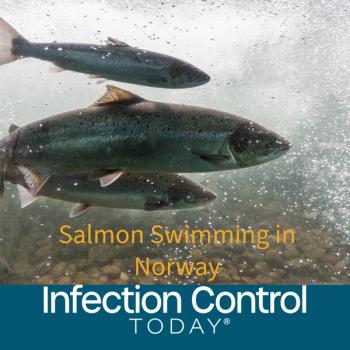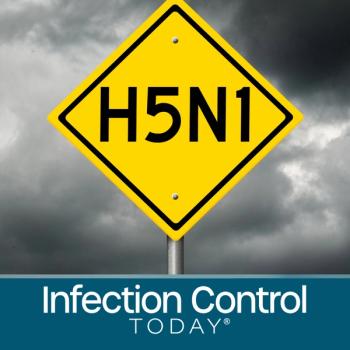
Insights into Appropriate Levels of PPE Contamination
Experts in infection prevention discuss PPE quality and highlight considerations relating to assessing appropriate levels of PPE contamination.
Episodes in this series

Heather Saunders, MPH, RN, CIC: Tracy, you mentioned enhanced respiratory precautions. Can you comment a little bit on what that is, and maybe also about whether we think universal masking, always wearing a mask in a healthcare facility, is going to be something that we continue for all patient interactions.
Tracy Field, RN, WCC, LALD, LTC-CIP: Sure. So as far as the enhanced respiratory precautions, that really came in light just when COVID came about us. And it's a mixture of the droplet precautions and contact precautions, and that is proven to help us eliminate the spread of COVID. And as far as universal masking goes, it doesn't seem like it's going away anytime soon. It does seem to be helping, during the pandemic, and it is protecting us and protecting our patients that we take care of.
Heather Saunders, MPH, RN, CIC: I think we also saw maybe the impact that universal masking had on seasonal flu outbreaks in decreasing the transmission of flu, as well. Could you comment a little bit on how the use of personal protection equipment has impacted and decreased the transmission of influenza?
Isis Lamphier, MPH, CIC: Yes, we've seen a couple of trends with influenza. When universal masking was in effect, we saw a decrease in influenza because patients were using mask and they were protecting others from their respiratory droplets. But once we saw mask policies change a little bit, and masks no longer were a requirement, then we did see an increase in influenza, as well. I think it's important that if we see a patient come in that has respiratory-like illnesses, or influenza-like illness, that we request that they don a clean mask. Typically, they should also be segregated while they're waiting for their appointment or coming into the hospital. So, they should be in a different waiting area. And we should also emphasize just standard precautions that hand hygiene is important, and preventing infections through our hands is critical because most infections are spread through our hands.
Heather Saunders, MPH, RN, CIC: I was looking at and seeing that the American Society of Testing and Materials Guidelines (ASTM) has changed a little bit, maybe in light of some of what we've experienced. But can you comment on what is required as far as ASTM ratings for face barriers and what that looks like?
Isis Lamphier, MPH, CIC: ASTM has set forth clear expected standards for the development of facial barrier protection, and that's in order to ensure quality and protection for the wearer. Manufacturers are required to perform a design analysis, and in that design analysis they have to assess for leakage of exhaled air from the barrier covering. And they also look at filtration efficacy and airflow resistance as well. There's different standards that have to be met, and they need to ensure that all of those performance properties are being met in their testing.
Heather Saunders, MPH, RN, CIC: Thank you. Thank you for that. Sounds like quality is so important. Knowing what type of personal protective equipment to use is so important. Think it's also so important for clinicians to understand PPE contamination and breaches. Can either one of you comment a little bit on where we see the most contamination on articles of personal protective equipment that clinicians need to be aware of?
Tracy Field, RN, WCC, LALD, LTC-CIP: I think doffing is where we see the biggest risk of contamination. Just it's so important to remove the equipment in a certain fashion. And then the biggest is hand hygiene.
Isis Lamphier, MPH, CIC: I think we also see contamination with prolonged use of PPE. A lot of individuals might not know that with prolonged PPE usage, they can be contaminating themself if they're continuing to use an unclean mask. And it's important to know the type of mask you're wearing or also your gown. Is it single-use disposable, or can you re-wear it? And if you can re-wear it, what are the proper conditions that have to be met? Do you have to disinfect it after use? We definitely see contamination when PPE is used outside of the instructions for use or the IFU, and it's important for wearers to understand what those specific requirements are for the PPE that they're wearing and if they can reuse it or use it for an extended period of time.
Heather Saunders, MPH, RN, CIC: Is there a specific area of personal protective equipment that seems to be the most contaminated? With doffing, I can assume that there is more of a risk in touching certain parts of personal protective equipment. Is that true?
Isis Lamphier, MPH, CIC: I think there are a couple. For example, mask. If a mask is reusable, for example if they're using a respirator, they need to properly store it after they remove it and also properly clean and disinfect it. Gloves can commonly cause contamination as well, especially if there's any tears in the gloves or microtears that you're unaware of. It's important to remove those gloves once they tear, perform hand hygiene, and then don a new set of gloves. It's also important to look at the CDC recommendations for removing PPE, so which items should be removed first and last, because that's sometimes a missed step when donning and doffing. It's important to note that when you're removing PPE, you want to go from your most contaminated item to your least contaminated. So, gloves should be removed first, and sometimes individuals might not want to remove those gloves first because then they're going to be touching their gown or their face shield or eye protection. So, it's important to perform that education so that they know which steps to take.
Tracy Field, RN, WCC, LALD, LTC-CIP: It is a very important skill that does need a lot of reeducation because you're busy. You need to move on to the next patient. You might not be as careful as you should be in following that exact process. But it is very important.
Newsletter
Stay prepared and protected with Infection Control Today's newsletter, delivering essential updates, best practices, and expert insights for infection preventionists.










